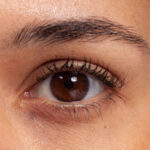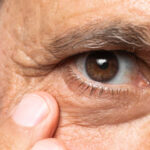Retinal detachment is one of the conditions that our team of highly qualified eye care professionals diagnose and treat, as part of a wide range of eye conditions in patients of all ages on a daily basis. While some of the conditions we help manage may be less serious, others may indicate a more concerning underlying issue that warrants further investigation – which is the category into which retinal detachment falls into. Retinal detachment occurs when the retina peels away or detaches from the back of the eye, and is considered a medical emergency as it can lead to vision loss without urgent medical care.
Thankfully, approximately 83% of people with retinal detachment have 20/40 vision or better after treatment,[1] – which is why it’s so important to be able to recognise the symptoms promptly and quickly book in with your eye care professionals for diagnosis and treatment. Retinal detachment is not typically painful, so doesn’t ring the typical “alarm bells” as with other injuries. Here’s a look into what retinal detachment is, what symptoms to watch for, and how a regular comprehensive eye exam can detect early eye changes before symptoms appear.
What Is Retinal Detachment?
Your retina is a thin layer of light-sensitive nerve cells that lines the back of the inside of your eye. When light enters your eye, it focuses on the retina, which absorbs the light and sends visual information to your brain along the optic nerve.
Retinal detachment occurs when the retina detaches or pulls away from its normal position at the back of the eye, disrupting the transfer of visual information to the brain. This can cause a person’s ability to see to be affected, and if left untreated, can result in permanent vision loss.
Initially, only a small part of the retina may tear or peel off, but without care and treatment, the entire retina can become detached. This can be caused by a variety of factors, including trauma to the eye, nearsightedness, previous cataract surgery, and other underlying health conditions.
Symptoms Of Retinal Detachment
A retinal detachment is generally not painful, and in the early stages, a retinal tear or detachment may not have any symptoms, or they may be so subtle that they’re unnoticeable until a person’s eyesight or eye health is assessed in an eye exam with an optometrist. Common symptoms may include:
A sudden increase in the numbers of floaters: floaters may appear as dots, circles, lines, squiggles or cobwebs in your vision, however they can take on almost any form, shape and size, and they may move quickly or remain quite still. Floaters form when clumps of cells or blood develop and ‘float’ in your vitreous, and cast a shadow on the retina.
A transparent grey curtain or dark shadow in your vision: as your retina detaches, a curtain or dark shadow may appear in your peripheral, or side vision, and gradually spread toward the centre of your field of vision.
Sudden, brief flashes of light: flashes happen when the vitreous pulls away from the retina and tugs on it, which results in small electrical signals being sent to the brain. The brain perceives these as short, small, flashes of light.
Causes Of Retinal Detachment
There are three types of retinal detachment, and each type is caused by different factors:
1. Rhegmatogenous retinal detachment
The predominant form of retinal detachment is referred to as rhegmatogenous retinal detachment. It occurs due to a tear, break or hole in the retina, enabling the vitreous fluid in the centre of the eye to pass through the opening and accumulate between the retina and the wall of the eye. This build-up eventually causes the retina to detach from its normal position at the back of the eyeball, resulting in vision loss if not treated promptly.
Diabetic retinopathy is a frequent cause of rhegmatogenous retinal detachment. As a person ages, changes in the consistency of the vitreous in the eye may occur, leading to its contraction and resulting in the formation of a small tear in the retina. Other possible causes of rhegmatogenous retinal detachment include eye injuries, eye surgery, and severe myopia or nearsightedness.
2. Exudative retinal detachment
Exudative retinal detachment, also known as secondary retinal detachment, is a type of retinal detachment that can occur without any tears, breaks or holes in the retina. This happens when fluid accumulates behind the retina, causing it to detach from the back of the eye.
The most common causes of exudative retinal detachment include leaking blood vessels or swelling in the back of the eye. These conditions can be triggered by a variety of factors such as eye injury or trauma, inflammation inside the eye, age-related macular degeneration, or rarely, tumours in the eye or Coats disease, which is a rare condition that causes abnormal development of blood vessels in the retina.
3. Tractional retinal detachment
Tractional retinal detachment happens when the retina is displaced from the back of the eye due to the presence of scar tissue pulling on it. The primary cause of tractional retinal detachment is also diabetic retinopathy, an eye condition that affects people with diabetes by harming blood vessels in the retina, which can cause the growth of scar tissue. As the scar tissue grows, it can pull on the retina and cause it to detach. Other possible causes of tractional retinal detachment include eye infections, injuries, and certain eye diseases like retinal vasculitis, sickle cell retinopathy, uveitis, or proliferative vitreoretinopathy.
Retinal Detachment Risk Factors
If you have any of the following risk factors, it’s important to get a comprehensive eye exam with a trusted eye care professional at least once every year, to monitor your eye health and pick up on changes before they are noticeable, and get you started on targeted treatment.
You are at an increased risk of retinal detachment if you have one or more of the following risk factors:
• Diabetes
• Aged over 50 years of age
• A family history of retinal detachment
• Severe short-sightedness
• Previous eye surgery e.g., cataract removal
• Eye injury or trauma
• Previous peripheral retinal degeneration or tears.
• Recurrent eye infections
• Other eye diseases
Concerned About Your Eye Health?
If you experience any symptoms of retinal detachment, it is important to contact your eye clinic immediately for prompt diagnosis and treatment. Even if you are not aware of any tears or detachment in your retina, having an eye exam can detect these changes in their earliest stages, before they progress to cause you symptoms. It is recommended to see an optometrist annually to monitor your vision and overall eye health, or more frequently if you notice any changes in your vision. During these appointments, your optometrist can assess the health of your eyes and rule out any serious issues, providing you with peace of mind and a clear plan for prompt treatment if necessary.
To book your comprehensive eye exam with one of our experienced team members, contact one of your local Optical Warehouse clinics across Queensland.
[1] https://www.ncbi.nlm.nih.gov/books/NBK551502/


